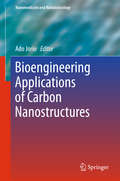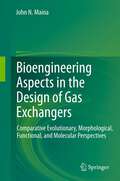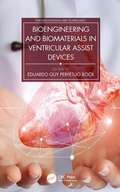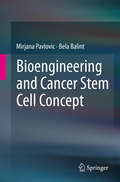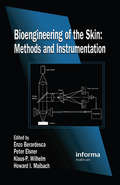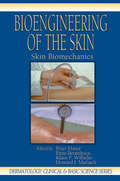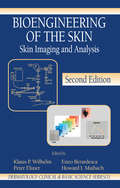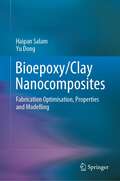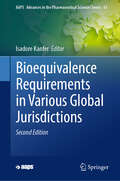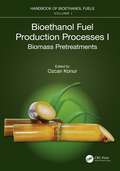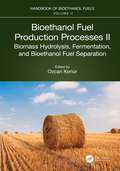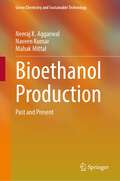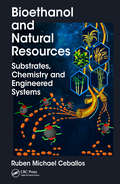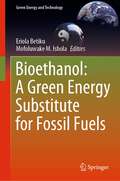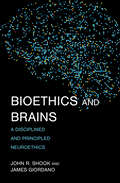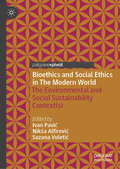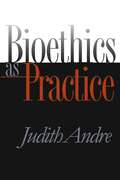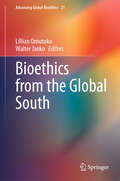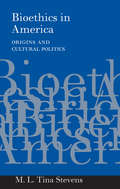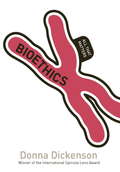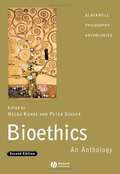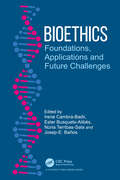- Table View
- List View
Bioengineering Applications of Carbon Nanostructures (Nanomedicine and Nanotoxicology)
by Ado JorioThis book covers the development of biotechnology based on carbon nanostructures, with a focus on nanotubes, addressing also fullerenes and amorphous carbons. The book is divided into 7 chapters, addressing tissue engineering, genetic engineering and therapy, as well as the environmental and health impacts of carbon nanostructures.
Bioengineering Aspects in the Design of Gas Exchangers: Comparative Evolutionary, Morphological, Functional, and Molecular Perspectives
by John N. MainaThis book encapsulates over three decades of the author's work on comparative functional respiratory morphology. It provides insights into the mechanism(s) by which respiratory means and processes originated and advanced to their modern states. Pertinent cross-disciplinary details and facts have been integrated and reexamined in order to arrive at more robust answers to questions regarding the basis of the functional designs of gas exchangers. The utilization of oxygen for energy production is an ancient process, the development and progression of which were underpinned by dynamic events in the biological, physical, and chemical worlds. Many books that have broached the subject of comparative functional respiratory biology have only described the form and function of the 'end-product,' the gas exchanger; they have scarcely delved into the factors and the conditions that motivated and steered the development from primeval to modern respiratory means and processes. This book addresses and answers broad questions concerning the critical synthesis of multidisciplinary data, and clarifies previously cryptic aspects of comparative respiratory biology.
Bioengineering and Biomaterials in Ventricular Assist Devices (Emerging Materials and Technologies)
by Eduardo Guy Perpétuo BockOften associated with artificial hearts, ventricular assist devices (VADs) are blood pumps that can provide circulatory assistance to the left ventricle, the right ventricle, or both. Bioengineering and Biomaterials in Ventricular Assist Devices reviews constructive details of VADs and the biomaterials used in their development and support. FEATURES Establishes an area of intersection between engineering and medicine Shows process development from mechanical design to automation and control Discusses biofunctional materials, tribology in ceramic biomaterials, biosensors, and surface engineering and blood This text is aimed at advanced students, researchers, and practicing engineers conducting work on VADs and will be of interest to a broad interdisciplinary group, including bioengineers, materials engineers, chemical engineers, mechanical engineers, and electrical engineers.
Bioengineering and Cancer Stem Cell Concept (SpringerBriefs in Computer Science #0)
by Bela Balint Mirjana PavlovicThis book explores the role of cancer stem cells in the diagnosis, treatment, and cure of cancers. This book also tackles novel methodology for cancer stem cell marker identification, cancer stem cell respiration and metabolism, genetic and epigenetic mechanisms including DNA methylation, and mi-RNA assemble. It also emphasizes the role of Bioinformatics techniques, which provide a novel methodology for modeling cancer outcomes. The authors investigate the difference between cancer stem cells and normal stem cells, along with the concept of targeted cancer stem cell therapy. Although the theoretical explanations of cancer stem cell involvement in leukemia and solid cancers are controversial, there is now little doubt that cancer stem cells exist within otherwise heterogeneous cancer cell population. The brief examines the two leading theories, hierarchical and the stochastic/cancer stem cell model. Researchers, professors and advanced-level students focused on bioengineering and computer science will find this book to be a valuable resource. It is a very good source of critical references for understanding of this problem, and a useful tool for professionals in related fields.
Bioengineering of the Skin: Methods and Instrumentation, Volume III (Dermatology: Clinical And Basic Science Ser. #9)
by Howard I. Maibach Peter Elsner Enzo Berardesca Klaus-P. WilhelmSkin bioengineering is an expanding field of investigative and clinical dermatology. This guide describes all commercially available techniques and instruments. It provides a thorough overview of methods for noninvasive investigation of skin function. Commercially available instruments are reviewed and compared, with updated references given for each instrument. This book offers a technical analysis of each instrument, allowing investigators to understand its biophysical principles and to make better purchases of lab instruments. Addresses of manufacturers and worldwide distributors are included, making this an essential reference source.Chapters are written by international experts. Topics include transepidermal water loss, hydration, the measurement of skin blood flow in Laser-Doppler flowetry, sebum, pH and ions, and transcutaneous pO2 and pO2 measurements. Skin color, roughness, and elasticity are examined in detail. Skin imaging techniques, capillaroscopy, and fluorescence videomicroscopy are described. Instruments for surface microscopy of the skin are also discussed.Bioengineering of the Skin explains state-of-the-art techniques and is valuable reading for anyone who needs to stay abreast of the latest activities in this ever-changing field.
Bioengineering of the Skin: Skin Biomechanics, Volume V
by Howard I. Maibach Peter Elsner Enzo Berardesca Klaus P. WilhelmSince skin forms the interface between the human body and the environment, its mechanical properties are important in health and disease. Bioengineering of the Skin: Skin Biomechanics gives a thorough introduction in the biological basis of skin biomechanics. It explains the non-invasive methods that allow measurement of the mechanical properties o
Bioengineering of the Skin: Skin Imaging & Analysis (Dermatology: Clinical & Basic Science)
by Howard I. Maibach Peter Elsner Enzo Berardesca Klaus-P. WilhelmSpanning the many advancements that have taken place in the field since the First Edition of this book was published, this Second Edition emphasizes the imaging of the skin in its entirety, rather than focusing solely on surface layers. The Second Edition includes new chapters on technologies such as in vivo confocal laser scanning microscopy, Rama
Bioengineering of the Skin: Water and the Stratum Corneum, 2nd Edition (Dermatology: Clinical & Basic Science)
by Joachim Fluhr Peter ElsnerBioengineering of the skin, or more precisely the biophysical assessment of skin physiology, is moving rapidly from a descriptive approach to a deeper understanding of biophysical and biochemical processes. This second edition of the popular text Bioengineering of the Skin: Water and Stratum Corneum reflects the progress in the field, focusing on t
Bioepoxy/Clay Nanocomposites: Fabrication Optimisation, Properties and Modelling
by Yu Dong Haipan SalamThis book highlights current advanced developments in bioepoxy and bioepoxy/clay nanocomposites and an optimisation of material formulation and processing parameters on fabrication of bioepoxy/clay nanocomposites in order to achieve the highest mechanical properties in relation to their morphological structures, thermal properties, as well as biodegradability and water absorption, which is based on the use of Taguchi design of experiments with the consideration of technical and economical point of view. It also elaborates holistic theoretical modelling of tensile properties of such bionanocomposites with respect to the effect of contents of nanoclay fillers and epoxydised soybean oil (ESO).
Bioequivalence Requirements in Various Global Jurisdictions (AAPS Advances in the Pharmaceutical Sciences Series #61)
by Isadore KanferAn important objective of Bioequivalence Requirements in Various Global Jurisdictions is to attempt to gather current and updated information, collated in a single source, regarding the various bioequivalence and related requirements to satisfy the regulatory requirements for the market approval of multi-source (generic) drug products in various global jurisdictions. In view of the dynamic nature of regulatory requirements which are usually regularly updated, updating these requirements to remain current is an important necessity to provide such information to drug manufacturers, regulatory agencies, pharmaceutical scientists and related health organizations and governments around the world in the quest to harmonize regulatory requirements for the market approval of generic products. The revised volume includes updated information based on recent guidances and guidelines from the respective regulatory agencies as well as important trends and descriptions relating to innovative approaches for bioequivalence assessment.
Bioethanol Fuel Production Processes. I: Biomass Pretreatments
by Ozcan KonurThis book presents research on biomass pretreatments, which are a fundamental part of bioethanol fuel production to make biomass more accessible. This book also includes an introductory section on the bioethanol fuels. Bioethanol Fuel Production Processes. I: Biomass Pretreatments is the first volume in the Handbook of Bioethanol Fuels (Six-Volume Set). The primary pretreatments at the macro level are the biological chemical, hydrothermal, and mechanical pretreatments of the biomass. It also has an introductory section on the biomass pretreatments at large for bioethanol fuel production. The major pretreatments at the micro level are the enzymatic and fungal pretreatments of the biomass as the biological pretreatments, acid, alkaline, ionic liquid, and organic solvent pretreatment pretreatments of the biomass as the chemical pretreatments, steam explosion and liquid hot water pretreatments of the biomass as the hydrothermal pretreatments, and milling, ultrasonic, and microwave pretreatments of the biomass as the mechanical pretreatments. The first volume also indicates that a wide range of pretreatments stand alone or in combination with each other fractionate the biomass to its constituents of cellulose, lignin, and hemicellulose and improve both sugar and bioethanol fuel yield, making this bioethanol fuel more competitive in relation to crude oil- and natural gas-based fossil fuels. This first volume is a valuable resource for the stakeholders primarily in the research fields of energy and fuels, chemical engineering, environmental science and engineering, biotechnology, microbiology, chemistry, physics, mechanical engineering, agricultural sciences, food science and engineering, materials science, biochemistry, genetics, molecular biology, plant sciences, water resources, economics, business, management, transportation science and technology, ecology, public, environmental and occupational health, social sciences, toxicology, multidisciplinary sciences, and humanities among others.
Bioethanol Fuel Production Processes. II: Biomass Hydrolysis, Fermentation, and Bioethanol Fuel Separation
by Ozcan KonurThis book provides an overview of the research on production processes for bioethanol fuels in general, hydrolysis of the pretreated biomass for bioethanol production, microbial fermentation of hydrolysates and substrates with yeasts for bioethanol production, and separation and distillation of bioethanol fuels from the fermentation broth, complementing the research on biomass pretreatments presented in the first volume. It presents an overview of the research on biomass hydrolysis in general, wood hydrolysis, straw hydrolysis, and cellulose hydrolysis for bioethanol fuel production in the first section for biomass hydrolysis. It provides an overview of the research on microbial hydrolysate fermentation for bioethanol production in general, alternative fermentation processes for bioethanol fuel production such as simultaneous saccharification and fermentation (SSF) and consolidated biomass processing (CBP) compared with the separate hydrolysis and fermentation (SHF) process, metabolic engineering of microorganisms and substrates for bioethanol fuel production, and utilization of Saccharomyces cerevisiae for microbial fermentation of hydrolysates for bioethanol fuel production in the second section for hydrolysate fermentation. It provides an overview of the research on the bioethanol fuel separation from the fermentation broth in the last section. This book is a valuable resource for the stakeholders primarily in the research fields of energy and fuels, chemical engineering, environmental science and engineering, biotechnology, microbiology, chemistry, physics, mechanical engineering, agricultural sciences, food science and engineering, materials science, biochemistry, genetics, molecular biology, plant sciences, water resources, economics, business, management, transportations science and technology, ecology, public, environmental and occupational health, social sciences, toxicology, multidisciplinary sciences, and humanities among others.
Bioethanol Production: Past and Present (Green Chemistry and Sustainable Technology)
by Naveen Kumar Neeraj K. Aggarwal Mahak MittalThis book provides the latest research on bioethanol production from first- and second- generation feedstock. Bioethanol has emerged as one of the main alternative biofuels in recent years. The book provides a perspective on the chemistry, sources and production of bioethanol highlighting the recent developments in the field.Through this book readers will learn basic and advanced bioethanol production technologies under one roof, including resource management and environmental and economic impacts. The topics discussed in the book will attract researchers and scholars focusing in this field as well as anyone who is interested in green and sustainable energy resources.
Bioethanol and Natural Resources: Substrates, Chemistry and Engineered Systems
by Ruben Michael CeballosBioethanol and Natural Resources: Substrates, Chemistry and Engineered Systems provides a comprehensive review of feedstocks, physiochemical and biological pretreatments, molecular substrates, cellulolytic and ligninolytic enzymes, and advanced technologies for producing bioethanol. Although this book provides a review of first-generation bioethanol feedstocks, chemistry, and processes, there is an emphasis on second-generation "cellulosic" ethanol production. With rapid advances in biofuels technologies and the continued global dependency on unsustainable extraction of fossil fuels, this text is timely. Although it is intended to be used as a supplemental text for advanced undergraduate or graduate level courses, the book is accessible to a non-academic audience. This book provides a unique opportunity to understand bioethanol production from the basic concepts and processes to the most cutting-edge technologies under development.
Bioethanol: A Green Energy Substitute for Fossil Fuels (Green Energy and Technology)
by Eriola Betiku Mofoluwake M. IsholaThis book looks deeply into the prospects for using ethanol as a greener alternative to fossil fuels and the technical and scientific issues that surround them. Ethanol, with its numerous advantages, has emerged as a promising contender to replace gasoline as a fuel source. Currently, it is commercially available as a blend with gasoline, commonly known as E10 and E25, utilizing various ratios of ethanol. Despite its clear benefits over gasoline, the widespread adoption of ethanol as a fuel remains hindered by its limited availability. In this insightful book, we aim to explore the multifaceted challenges surrounding ethanol's full integration into our energy landscape, employing a comprehensive approach through review manuscripts. Leading worldwide experts, known for their deep understanding of ethanol as a fuel, have contributed to the book. Their valuable insights and contributions enrich the book's content, offering readers a comprehensive exploration of the subject matter. This book is a compelling resource for researchers, energy professionals, and anyone interested in understanding the challenges and opportunities associated with the integration of ethanol as a substitute for gasoline.
Bioethics and Brains: A Disciplined and Principled Neuroethics (Basic Bioethics)
by John R. Shook James GiordanoHow neuroethics can be increasingly relevant and informative for inclusive social policy and political discourse about brain science and technologies.Neuroethics, a field just over two decades old, addresses both ethical issues generated in and by brain sciences and the neuroscientific studies of moral and ethical thought and action. These foci are reciprocally interactive and prompt questions of how science and ethics can and should harmonize. In Bioethics and Brains, John R. Shook and James Giordano ask: How can the brain sciences inform ethics? And how might ethics guide the brain sciences and their real-world applications?The authors&’ structure for a disciplined neuroethics reconciles science and ethics by requiring ethical principles consistent with moral neuroscience and moral psychology. Their cosmopolitan perspective looks beyond Western theories toward a new metaethics for neuroethics and illustrates its approach in chapters that address the issues and approaches to questions and problems generated by the proliferation of neurotechnology in global contexts. Shook and Giordano posit that neuroethics can merge science and ethics toward establishing global consensus on guiding brain research, neurotechnological innovation, and grounding neurorights.
Bioethics and Social Ethics in The Modern World: The Environmental and Social Sustainability Context(s)
by Nikša Alfirević Ivan Pavić Suzana VuletićThis book explores the philosophical analysis of attitudes and values and sustainable behaviors in fields such as healthcare, social sciences, economics in the context of environmental studies. It firstly investigates the fundamental concept of bioethics with relevant case studies related to the issues of human life and preservation of dignity. The authors then move on to discuss the application of (bio)ethical principles in contemporary society and within the market economy. The last part of the book brings together a variety of perspectives on the general philosophical and ethical foundations of sustainable behavior based on the idea of human dignity. This book offers a guide to understanding responsible sustainability practices in various fields, while considering the social benefits and economic effectiveness of sustainable behaviors.
Bioethics as Practice
by Judith Andre<P>Those who work in bioethics and the medical humanities come from many different backgrounds, such as health care, philosophy, law, the social sciences, and religious studies. The work they do also varies widely: consulting on ethical issues in patient care, working with legislatures, dealing with the media, teaching, speaking, writing and more. <P>Writing as a participant in this developing field, Judith Andre offers a model to unify its diversity. Using the term "bioethics" broadly, to include all the medical humanities, she articulates ideals for the field, identifies its temptations and moral pitfalls, and argues for the central importance of certain virtues. Perhaps the most original of these is the virtue of choosing projects well, which demands not only broadening the field's focus but also understanding the forces that have kept it too narrow. Andre offers an imaginative analysis of the special problems presented by interdisciplinary work and discusses the intellectual virtues necessary for its success. She calls attention to the kinds of professional communities that are necessary to support good work. <P>The book draws from interviews with many people in the field and from the findings of social scientists. It includes the author's personal reflections, several extended allegories, and philosophical analysis. <P>Those who work in bioethics and the medical humanities come from many different backgrounds: health care, philosophy, law, social sciences, religious studies, and more. The work they do also varies widely. Writing as a participant in this developing field, Judith Andre offers a model to unify its diversity. Using the term "bioethics" broadly, to include all the medical humanities, she articulates ideals for the field, identifies its temptations and moral pitfalls, and argues for the central importance of certain virtues.-->
Bioethics from the Global South (Advancing Global Bioethics #21)
by Lillian Omutoko Walter JaokoThis book tackles complex global issues like vaccination, climate change, environmental ethics, embryo adoption, and surrogate motherhood viewed from the perspective of the global south. The COVID-19 pandemic has emphasized the need for addressing bioethical issues on a global scale, beyond national and regional boundaries. Challenges highlighted in the book include cultural differences, multi-pluralism, insufficient funding, and limited opportunities for awareness and provision of education in global bioethics, particularly in low and middle-income countries. The book employs universal and global bioethics frameworks, referencing the Universal Declaration of Human Rights and the UNESCO Universal Declaration on Bioethics and Human Rights. These documents, along with other international agreements and national constitutions were used to advocate for human dignity, health, and fundamental freedoms. Contributions from authors in Kenya, Uganda, and Nigeria provide valuable perspectives, making this book a must-read for ethicists, bioethicists, medical students, and healthcare workers with an interest in global bioethics.
Bioethics in America: Origins and Cultural Politics
by M. L. StevensIn Bioethics in America, Tina Stevens challenges the view that the origins of the bioethics movement can be found in the 1960s, a decade mounting challenges to all variety of authority. Instead, Stevens sees bioethics as one more product of a "centuries-long cultural legacy of American ambivalence toward progress," and she finds its modern roots in the responsible science movement that emerged following detonation of the atomic bomb.Rather than challenging authority, she says, the bioethics movement was an aid to authority, in that it allowed medical doctors and researchers to proceed on course while bioethicists managed public fears about medicine's new technologies. That is, the public was reassured by bioethical oversight of biomedicine; in reality, however, bioethicists belonged to the same mainstream that produced the doctors and researchers whom the bioethicists were guiding.
Bioethics, Public Moral Argument, and Social Responsibility (Routledge Annals of Bioethics)
by Nancy M. P. King Michael J. HydeBioethics, Public Moral Argument, and Social Responsibility explores the role of democratically oriented argument in promoting public understanding and discussion of the benefits and burdens of biotechnological progress. The contributors examine moral and policy controversies surrounding biomedical technologies and their place in American society, beginning with an examination of discourse and moral authority in democracy, and addressing a set of issues that include: dignity in health care; the social responsibilities of scientists, journalists, and scholars; and the language of genetics and moral responsibility.
Bioethics: All That Matters
by Donna DickensonIn this book:Donna Dickenson - Winner of the International Spinoza Lens AwardShould we do what ever science lets us do?Bioethics: All That Matters, new developments in biotechnology like genetics, stem cell research and artificial reproduction arouse both our greatest hopes and our greatest fears. Many people invest the new biotechnology with all the aspirations and faith once accorded to religious salvation. But does everyone benefit equally from scientific progress? Commercialised modern biomedicine runs the risk of exploiting vulnerable groups, from Indian 'surrogate' mothers to professional guinea pigs in drug research. Professor Dickenson argues that although we've entered new scientific territory, there's no need to jettison our existing moral sense. By discussing a range of real-life cases, she equips readers to make up their own minds on these important and controversial questions. Good science and good ethics needn't be contradictory.This accessible and concise book will appeal to both students and general readers, giving a fascinating introduction to a wide range of perspectives on Bioethics.All That Matters books:All books in the All That Matters series are written by world experts in their subject field. These experts work to distil a topic and get right to its heart, making the book accessible for both students and general readers. Each compelling book contains new and interesting perspectives and tells stories that matter.The Author:All That Matters - Interesting introductions to important issuesBooks on the following subjects are available from the All That Matters series: Muhammad, God, Water, Political Philosophy, Sustainability, Philosophy, Intelligence, Love, Russian Revolution, War, and Creativity.To find out more visit: www.allthatmattersbooks.com
Bioethics: An Anthology (Second Edition)
by Peter Singer Helga KuhseThe expanded and revised edition of Bioethics: An Anthology is a definitive one-volume collection of key primary texts for the study of bioethics. Brings together writings on a broad range of ethical issues relating such matters as reproduction, genetics, life and death, and animal experimentation. Now includes introductions to each of the sections. Features new coverage of the latest debates on hot topics such as genetic screening, the use of embryonic human stem cells, and resource allocation between patients. The selections are independent of any particular approach to bioethics. Can be used as a source book to complement A Companion to Bioethics (1999).
Bioethics: An Introduction for the Biosciences
by Ben MephamBioethical issues remain front-page news, with debate continuing to rage over issues including genetic modification, animal cloning, and 'designer babies'. With public opinion often driven by media speculation, how can we ensure that informed decisions regarding key bioethical issues are made in a reasoned, objective way? Bioethics: An Introduction for the Biosciences offers a balanced, objective introduction to the field of bioethics, ideal for any biosciences student who is new to the subject. With a focus on developing the students' power of reasoning and judgement, the book presents different perspectives to common themes in an impartial way, fostering debate and discussion. The opening section, 'The Ethical Groundwork', introduces students to the nature of bioethics and ethical theory. The book goes on to lead students through a broad range of bioethical issues relating to people, animals, and food, before concluding with an overview of bioethics in practice. The current generation of students will become the next generation of decision makers. Bioethics: An Introduction for the Biosciences is the perfect introduction to a field with which every biosciences student should be familiar. Online Resource Centre The Online Resource Centre features: For registered adopters of the book: - Figures from the book in electronic format, ready to download For students: - A web link library and hyperlinked reference list, giving ready access to additional information sources; - Topical updates: extensive summaries of the latest developments in those topics covered in the book, ensuring that the reader can remain up-to-date at all times.
Bioethics: Foundations, Applications and Future Challenges
by Irene Cambra-Badii Ester Busquets-Alibés Terribas-Sala Núria Josep-E. BañosThe aim of this book is to introduce and discuss bioethics in a three-synergistic way: from the foundations to the current debates in relation to healthcare and social bioethics, and thereafter the possible future challenges. In this sense, the target audience can be from diverse disciplines: life and medical sciences, law, philosophy, psychology, and education. The book will be useful to high school students, in their first contacts with bioethics, college students, teachers and researchers, and the general public interested in these controversial debates of the past, present and future of bioethics.
